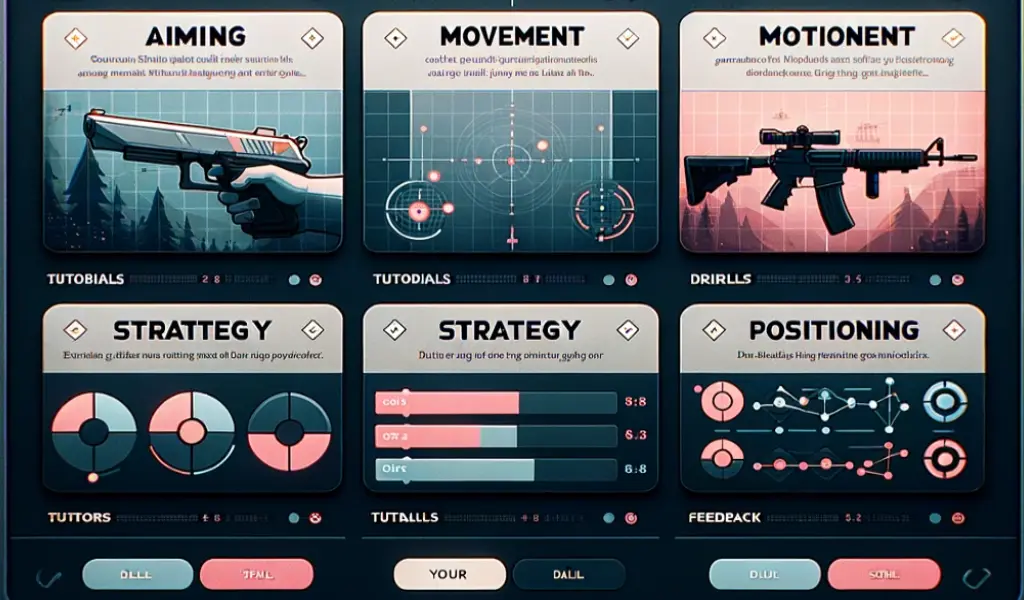Training
CS2 Training Guide
Counter-Strike 2 (CS2), an immersive and rapid-fire first-person shooter game, demands strategic prowess, clear communication, and swift reflexes from its players. To excel at the game, you’ll need to invest considerable time honing your skills. This comprehensive guide provides in-depth strategies and tips for effective training and improvement.
CS2 Skills
This list of skills is ordered by importance, but to become good in CS2, you need to master all of these:
- Crosshair placement
- Movement (AD stepping, correct peeking)
- Game Sense
- Aiming & Recoil
- Reflexes / Awareness
- Map knowledge
- Economy / Money management / Weapon decisions
- Communication / Mentality

Understanding the Basics
Understanding the fundamental mechanics of CS2 is the first and arguably one of the most crucial steps in ineffective training. The mechanics of the game encompass a wide range of skills, from shooting accurately and moving tactically, to efficiently utilizing equipment such as grenades, all of which contribute to your overall performance.
Moreover, familiarizing yourself with the CS2 maps is also essential. Each map has its unique layout and features, understanding which can give you a strategic advantage over your opponents. CS2’s communication component also leans heavily on map knowledge, with specific locations on each map referred to by their “callouts”. Learning these callouts and being able to quickly communicate your opponents’ locations to your team can often spell the difference between winning and losing a round.
Aim Training
In CS2, aiming is one of the fundamental skills you’ll need to master. Good aim can often tip gunfights in your favor, especially in closely contested encounters. Here are some strategies for improving your aim:
Use Aim Maps
CS2 provides a selection of aim maps specially designed to help players enhance their aiming skills. These maps feature targets or bots that you can practice shooting at, simulating the dynamics of a real game environment. Spending a dedicated amount of time each day on these maps can help sharpen your aim and reflexes over time.

Crosshair Placement
An underrated aspect of aiming is good crosshair placement, especially on T side. Playing crosshair placement maps and clearing angles one by one is CRUCIAL for a good player. Wide swinging every time and flicking to opponents may work in your matchmaking but consistency vs. good players can only be achieved by knowing every possible enemy position and clearing it with focus.
Train with Different Weapons
Each weapon in CS2 has a unique recoil pattern. Mastering these patterns and practicing recoil control can significantly enhance your accuracy during gunfights, even when firing in full-auto mode. Start by practicing with one weapon and gradually expand your arsenal as you get more comfortable.
Headshot Practice
In CS2, landing a headshot can instantly eliminate an opponent, making them a high-reward aim point. However, due to the character model’s size, they also present a small target and can be challenging to hit consistently, especially against moving targets. Devote part of your aim training to practice your precision and reflexes for landing headshots.
Game Sense
Game sense refers to your understanding of the game’s flow, your ability to interpret ongoing events, and accurately predict future outcomes. A well-honed game sense can often compensate for a lack of raw aiming skills. Here’s how you can develop it:
Watch Pro Players
One of the most effective ways to improve your game sense is by watching professional CS2 players. Observing how they strategize, communicate, respond to various game scenarios, and coordinate as a team can provide valuable insights. You can apply these learnings to your games, helping you understand the game’s meta and anticipate common strategies.
Play the Game
There’s no substitute for direct experience. The more you play CS2, the more familiar you become with its dynamics and mechanics. Aim to play a few matches each day; over time, you’ll naturally develop an intuition for player behavior, strategic play, and advanced tactics.
Communication
Effective communication can often be the difference between winning and losing in CS2. Keeping your team updated about your actions, enemy positions, and other relevant game information is crucial.
Clear Callouts
Ensure your callouts are clear, concise, and to the point. Avoid unnecessary chatter that could clutter the communication channel and distract your team. Effective callouts can expedite decision-making and improve your team’s response time to threats.
Listen to Your Team
Remember, communication is a two-way process. While it’s important to relay relevant information to your teammates, it’s equally critical to actively listen to their callouts and suggestions. A cohesive team that communicates effectively can often overcome more skilled but less coordinated opponents.
Regular Practice
Regular practice is key to mastery in any domain, and CS2 is no exception. However, it’s not just about the quantity of practice, but also the quality. Here are some tips to make the most of your practice sessions:
Aim to Improve
While winning is an objective in every match, during practice, your primary goal should be to improve. Focus on refining specific aspects of your game in each session. It could be aim, map awareness, grenade usage, or another aspect you believe needs work.
Review Your Matches
Invest time in reviewing and analyzing your matches. Look for mistakes, identify patterns, and spot missed opportunities. Reflecting on your performance can provide valuable insights and highlight areas you need to focus on in your subsequent training sessions.
Stay Positive
Improvement often comes slowly and requires patience. Don’t get discouraged if you don’t see instant results. Remember, even the top players have been through countless hours of practice and numerous losses. Stay positive, keep practicing, and your skills will inevitably improve over time.